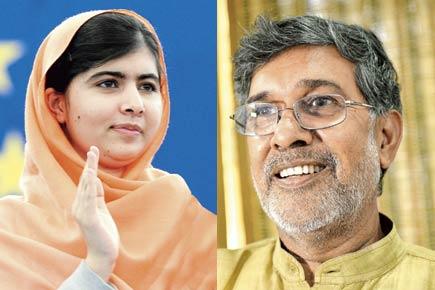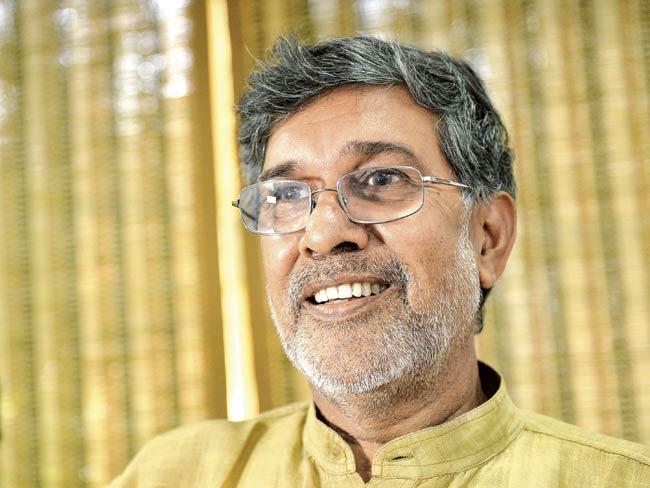At a time of cross-border firing and heated exchange of words between the two nuclear-armed countries, 60-year-old Kailash Satyarthi from India and 17-year-old Malala Yousafzai from Pakistan shared the Nobel Peace Prize for their work on promoting child rights in the sub-continent

Nobel Peace Prize, Kailash Satyarthi, Malala Yousafzai, child rights, peacemakers, Bachpan Bachao Andolan, cross-border firing, Indo-Pak relations, India, Pakistan

Malala Yousafzai
Malala Yousafzai was in her classroom at her school in Birmingham, England, when she was informed that she has been awarded the Peace Prize, becoming the youngest Nobel laureate.
On October 9, 2012, a Taliban gunman shot Malala as she was on her way home on a school bus, for advocating education for girls in her district.
Despite surviving the near-fatal shooting, the 17-year-old resolutely expressed her determination to carry on with her campaign for child rights and girls education, especially in Pakistan.
To hell and back
>> In early 2009, the then 12-year-old wrote a blog under a pseudonym for the BBC about her life under Taliban occupation
>> She was nominated for the International Children’s Peace Prize by South African activist Desmond Tutu
>> After the attack, a UN petition was launched using the slogan ‘I am Malala’, which led to the ratification of Pakistan’s first Right to Education Bill.
>> In April 2013, Malala was featured on the cover of Time magazine as one of the ‘100 Most Influential People in the World’
>> She was the winner of Pakistan’s first National Peace Prize Award. In July 2013, Malala spoke at the UN, to call for worldwide access to education
Nobel committee says
Despite her youth, Malala Yousafzai has already fought for several years for the right of girls to education, and has shown by example that children and young people, too, can contribute to improving their own situations. This she has done under the most dangerous circumstances. Through her heroic struggle, she has become a leading spokesperson for girls’ rights to education.
Did you know?
Malala was named after Malalai of Maiwand, a famous Pashtun poet and warrior woman from southern Afghanistan

Kailash Satyarthi
A former engineer, Kailash Satyarthi has been associated with the struggle to free bonded labourers for decades. He founded the Delhi-based NGO Bachpan Bachao Andolan (Save Childhood Movement) in 1980, which actively participates in rescue operations along with the police and the labour department, and helps the children reunite with their families.
The 60-year-old has headed various forms of peaceful protests focussing on the exploitation of children. Through Supreme Court orders, Kailash has saved children forced to embroider textiles in New Delhi, weave carpets in Uttar Pradesh and work on rice fields in Madhya Pradesh.
A three-decade campaign
>> In the 1980s, Kailash founded the Mukti Ashram to teach bonded labourers, especially children, new trades so that they could participate freely in the economy
>> Kailash established Rugmark, now called Goodweave, as the first voluntary monitoring and certification system of rugs manufactured without the use of child-labour
>> In 1998, he organised the Global March Against Child Labour in 103 countries, which helped pave the way for an International Labour Organisation convention
>> He has been a member of a UNESCO body established to examine child labour, and has been on the board of the Fast Track Initiative
>> He is now reportedly working on bringing child labour and slavery into the post-2015 development agenda for the UN’s Millennium Development Goals
Nobel committee says
Showing great personal courage, Kailash Satyarthi, maintaining Gandhi’s tradition, has headed various demonstrations and protests, all peaceful, focussing on the grave exploitation of children for financial gain. He has also contributed to the development of important international conventions on children’s rights.
Did you know?
Kailash Satyarthi is the second Indian, after Mother Teresa, to win the Nobel Peace Prize
 Subscribe today by clicking the link and stay updated with the latest news!" Click here!
Subscribe today by clicking the link and stay updated with the latest news!" Click here!









